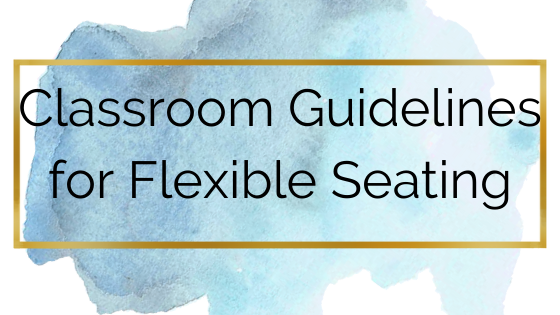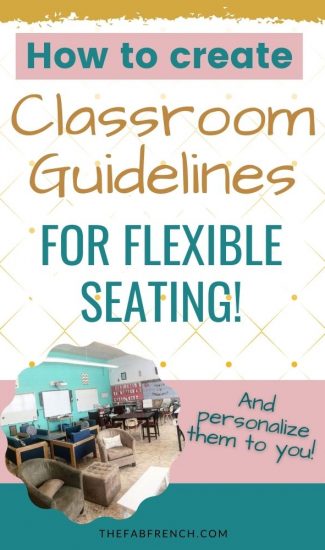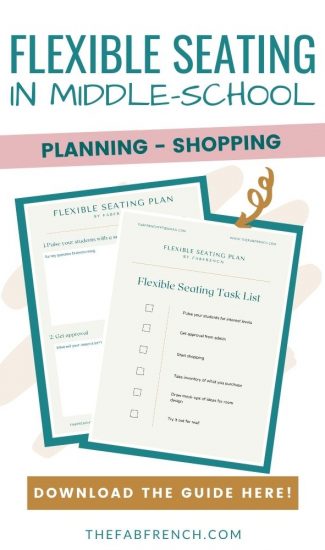We are back for Part 3 of the Flexible Seating in Middle-School blog series! If you missed Part 1: 5 Steps to Flexible Seating in Middle-School and Part 2: Furniture for Flexible Seating in Middle-School, please check them out to make sure you haven’t missed anything super important!
Part 3 is here! We’ll be discussing the idea of classroom guidelines for flexible seating.
When people (parents and colleagues) see my classroom, one of the first things they ask me is, “How do you keep the kids on task when they are seated this way?” Or, “Don’t you find that the kids have a hard time focusing when like this?”
And the answer is always “NO!”
Why? Because the kids get to choose where they want to sit and usually they are able to find a place that works for them.
Unpopular opinion alert…. I also believe that if you have a good relationship with your students then you will see WAY fewer unexpected behaviours.
BUT, it’s still important to have ground rules in your flexible seating classroom and that is what I will help you with today.
I’m not here to tell you what rules to have because it really depends on your environment. Do you have the same kiddos all day? Do they switch every period? What do you teach? Etc.
I will guide you to create your own list of expectations that you can either present to your students, or you can guide your students to create cooperatively with you. You choose 🙂
Let’s get started!
I choose to keep it as simple as possible so that the “rules” are easy to remember and I have them posted in my classroom so that I can always easily refer to them. I suggest trying to stick to 3-5 “rules”/guidelines.
Read through the following questions and reflect upon your answers and your preferences.
Do you teach the same kiddos all day or do you teach multiple classes a day?
- If you teach the same kiddos you may allow them to keep their belongings in their space, or you may want to have an am/pm seating switch.
Do your kiddos have clean indoor shoes for school or do they only have one pair of shoes?
- If they have indoor shoes, you may not mind if they put their feet up on the furniture, but if they wear their outdoor shoes inside the school, you may want to have a guideline that asks students to keep their shoes off the furniture. If your board allows it, you could ask students to remove their shoes if they want to put their feet up.
Do you want a seating plan? (Chosen by the kids.) Or do you want seating to be open? (Meaning the kids can choose a different spot every day.)
- I personally did open seating so that the kids could choose a different spot every day but I found that once they had chosen they tended to just sit in the same spot every day anyway. To encourage movement and to allow kids to try different spots, I asked them to choose new spots every month.
Will you put covers on your furniture to protect it? Do you mind if kiddos draw on the furniture?
- If you are concerned about the furniture being defaced/drawn on, I would recommend finding ways to cover them. If you have chairs/couches, I would suggest getting covers that can simply be thrown in the wash. For tables, you can get tablecloths or you could cover the table with contact paper.
Do you want to allow the kiddos to move the furniture around the room and change up the general design of the space?
- When you have set up your space before classes start you’ll have an idea of how you want the furniture to be arranged. You will need to decide if you want your kiddos to be able to manipulate the arrangements or if the seating areas you have set up need to stay that way.
Hopefully these questions have gotten you thinking about different guidelines you may like to have in your classroom and what kind of flexible seating environment you’d like to have
Just for reference, my classroom contract looks like this:
- I will respect myself.
- I will respect others.
- I will respect the space.
“I will respect myself” indicates to the students that they are responsible for choosing a space in which they could work and thrive.
“I will respect others” indicates to the students that they are responsible for respecting the learning of the students around them. And of course their teacher.
“I will respect the space” indicates to the students that they are responsible for respecting the furniture by not picking at it, drawing on it, or putting their shoes on it.
That’s it! Now you’re ready to implement flexible seating in your middle-school classroom! Please let me know if there’s anything you feel I’ve missed or if you have any questions/need support!
Good luck and have fun!



